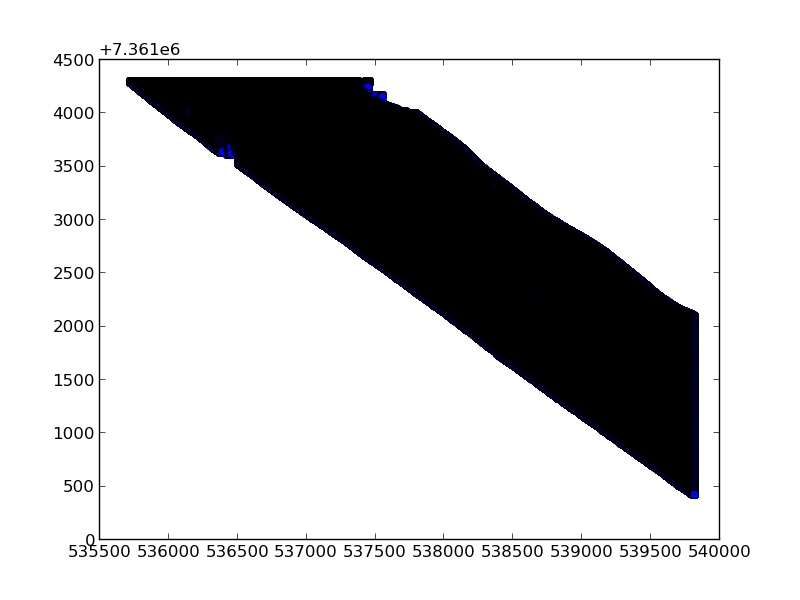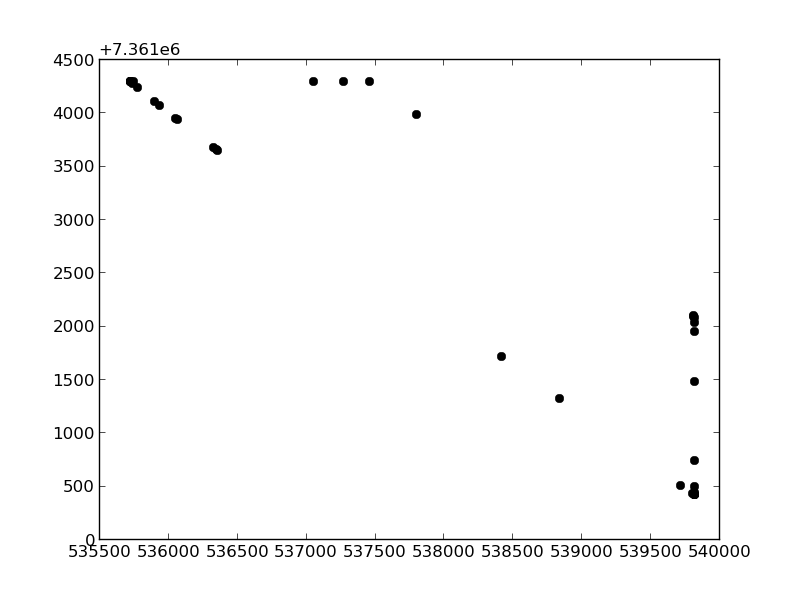Calculating the convex hull of a point data set (Python)
Working with LiDAR point data it was necessary for me to polygonize the point cloud extent. A first approach was to calculate the convex hull of the points. This is predominantly facilitated using scipy spatial’s ConvexHull function.
For my application I required the hull points to be printed out into a txt/csv in order of position (i.e. going clockwise around the hull). This is enabled by simply pulling out the “vertices” from the spatial.ConvexHull object - this gives the indicies of the convex hull points within the original xy input file:
hull = spatial.ConvexHull(xy_file, qhull_options="Qt")
hull_indices = hull.verticesThis is all integrated into a single function:
import os
import sys
import numpy as np
from scipy import spatial
def xy_convex_hull(input_xy_file):
'''
Calculates the convex hull of a given xy data set
returning the indicies of the convex hull points
in the input data set. A convex hull point
co-ordinate file is then created using
write_convex_hull_xy()
'''
if os.path.isfile(input_xy_file):
print "Loading file...."
xy_file = np.loadtxt(input_xy_file, usecols= (0,1))
else:
sys.exit("File for convex hull calculation doesn't exist")
print "Calculating hull points..."
hull = spatial.ConvexHull(xy_file, qhull_options="Qt")
hull_indices = hull.vertices
print "Found %d hull points" % len(hull_indices)
print "Hull indicies calculated and now being returned..."
return xy_file, hull_indiceshull_indicies - which more precisely are the “[i]ndices of points forming the simplical facets of the convex hull” - will look something like this:
array([17218337, 48757, 3476, 1517, 649, 73,
38, 37, 1, 0, 209, 27606,
153490, 154907, 1422687, 1435840, 1455472, 1933477,
2183734, 2185942, 2754182, 2977613, 3100991, 7573831,
8619400, 14809551, 15214362, 16139836, 16146528, 16188976,
16204639, 16351763, 16649880, 17150945, 17153685, 17260738,
17268373, 17273051, 17275385, 17299918, 17300751, 17304440,
17307723, 17318805, 17319327, 17319315, 17319198, 17290692,
17286814, 17282596, 17279306], dtype=int32)The hull vertex indices (hull_indices) can then be passed in with the main xy point file (xy_file) (along with an output path (opath) and output file name (file_name) to the below function which writes out the xy positions of hull_indices from xy_file (in the format I required):
def write_convex_hull_xy(xy_file, hull_indices, opath, file_name):
'''
Takes the convex hull verticies (an array of indicies) and
uses them to extract and write out the convex hull vertex
co-ordinates to a file
'''
file_name = "%sconvex_hull_vertices_%s.txt" %(opath, file_name)
f = open( file_name, 'w')
for i in range(len(hull_indices)):
index = hull_indices[i]
value_y = xy_file[index, 0].astype('float32')
value_x = xy_file[index, 1].astype('float32')
f.write("%f %f\n" %(value_y, value_x))
f.close()This should give something similar to the following:
540460.812500 7362116.000000
540473.875000 7362116.000000
540473.937500 7362116.000000
540475.687500 7362133.000000
540475.875000 7362134.500000
540478.750000 7362163.000000
... etc.Ultimately, from this xy point dataset:

I managed to get the following:
